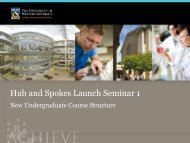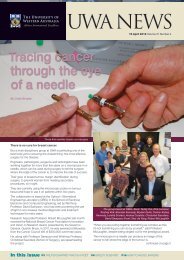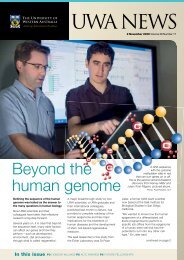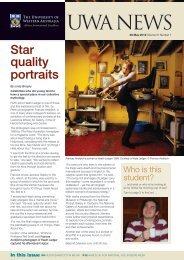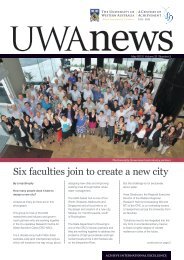Issue 13. 6 September 2010.pdf [PDF File, 1.7 MB] - UWA Staff - The ...
Issue 13. 6 September 2010.pdf [PDF File, 1.7 MB] - UWA Staff - The ...
Issue 13. 6 September 2010.pdf [PDF File, 1.7 MB] - UWA Staff - The ...
Create successful ePaper yourself
Turn your PDF publications into a flip-book with our unique Google optimized e-Paper software.
Behind<br />
biomedical<br />
research:<br />
the two-legged and f<br />
(from left) Geoff Billiewicz (operations coordinator), Malcolm Lawson (Manager Animal Care Services), Lauren Callahan (veterinary<br />
officer), Marilyn Davies (quality control manager) and Simone Chapple (facilities manager): leading the Animal Care staff.<br />
A cancer researcher has paid<br />
$25,000 for a custom-bred mouse for<br />
his work.<br />
Another group is having guinea pigs<br />
brought in from Germany because the<br />
local ones have characteristics that<br />
compromise specific research.<br />
<strong>The</strong>se are the specialist animal services<br />
provided every day by <strong>UWA</strong> staff at the<br />
Biomedical Research Facility at Shenton<br />
Park.<br />
<strong>The</strong>y also care for and prepare for<br />
research about 10,000 (non-specific)<br />
mice, 2,000 rats, up to 1,000 guinea<br />
pigs, a couple of hundred rabbits, up to<br />
800 sheep at a time, wallabies, quokkas,<br />
ducks, pheasants, emus, pigeons,<br />
ferrets, pigs, goats and alpaca.<br />
“<strong>The</strong>re are millions of dollars tied up in<br />
animal acquisition, breeding, housing,<br />
quality control and care behind the<br />
research at <strong>UWA</strong>,” said Animal Care<br />
Services Manager, Mal Lawson. “But<br />
very few people ever hear about us.”<br />
Dr Lawson said remarkable progress<br />
had been made over the past few years<br />
in the care of animals but using them for<br />
research was still an emotional issue for<br />
many people. So it was understandable<br />
that, despite excellent facilities and<br />
systems, little was heard about that<br />
aspect of research.<br />
“For example, a recent issue of<br />
<strong>UWA</strong>news featured seven researchers<br />
and their groups who use our facilities<br />
and expertise,” he said.<br />
<strong>The</strong> award-winning Biomedical Research<br />
Facility was opened nearly four years<br />
ago, and safety and wellbeing of both<br />
staff and animals is constantly under<br />
review.<br />
“We provide the best animals for research<br />
and the best conditions for those<br />
animals,” Dr Lawson said. “For example,<br />
our rabbit behavioural enrichment<br />
program means we constantly have<br />
rabbit playtime sessions going on. We are<br />
trying different nesting and bedding<br />
materials for our mice to try to recreate<br />
real life conditions. And although our<br />
animals can’t be free-ranging outside<br />
(because we have to supervise them<br />
closely), we are always evaluating and<br />
developing new and different systems,<br />
such as the best flooring for the comfort<br />
and welfare of our sheep.<br />
“We work with industry partners to come<br />
up with the best designs for both the<br />
animals and the staff.”<br />
Other universities make use of the <strong>UWA</strong><br />
facilities, which helps to pay for the<br />
maintenance of the animals. “An<br />
enormous amount of money and effort<br />
goes into this facility,” Dr Lawson said.<br />
About 40 people work at the facility and<br />
hundreds of researchers are in and out<br />
every week.<br />
8<br />
<strong>UWA</strong> NEWS 6 <strong>September</strong> 2010<br />
<strong>The</strong> University of Western Australia


![Issue 13. 6 September 2010.pdf [PDF File, 1.7 MB] - UWA Staff - The ...](https://img.yumpu.com/26619782/8/500x640/issue-13-6-september-2010pdf-pdf-file-17-mb-uwa-staff-the-.jpg)
